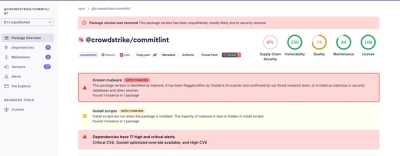
Research
Malicious fezbox npm Package Steals Browser Passwords from Cookies via Innovative QR Code Steganographic Technique
A malicious package uses a QR code as steganography in an innovative technique.
django-fineforms
Advanced tools
.. image:: https://github.com/matthiask/django-fineforms/workflows/Tests/badge.svg :target: https://github.com/matthiask/django-fineforms
This library offers an improved replacement for Django's own form
rendering methods (as_p, as_table etc.) while staying simple
and extensible but without introducing a whole new framework.
django-fineforms consists of a template tag library and a few opinionated default templates.
Simply pip install django-fineforms, and add fineforms to your
INSTALLED_APPS.
The template tags mostly wrap their arguments in wrapper classes that do
the real work. For example, {% ff_field %} simply wraps the passed
field in a wrapper defined in the FINEFORMS_WRAPPERS setting. All
wrappers use a template to render their output. The default wrapper
types are as follows:
.. code-block:: python
{
"errors": ErrorsWrapper,
"field": FieldWrapper,
"field-plain": PlainFieldWrapper,
"fields": FieldsWrapper,
}
The wrappers themselves mostly aren't configurable, but you can replace
individual wrappers (or all of them) by adding a FINEFORMS_WRAPPERS
setting. You do not have to override all of them; if you only want to
add another wrapper for a specific field type you could just set:
.. code-block:: python
FINEFORMS_WRAPPERS = {
"specific": "app.wrappers.SpecificWrapper",
}
... and use this wrapper as {% ff_field some_field type='specific' %}
somewhere in your templates.
All template tags are contained in the fineforms library.
{% ff_field field [type=field] %}
Template: ``fineforms/field.html``
Render a single field. The wrapper can be optionally overridden by
passing a different type. The key has to exist in the
``FINEFORMS_WRAPPERS`` dictionary.
The default implementation renders the label, the widget, help text and
errors related to the field. It is recommended to also set the
``error_css_class`` and ``required_css_class`` form attributes; those
classes are also added to the output.
The ``field-plain`` type can be used if the widget should be rendered
alone. A wrapping ``<span>`` tag still contains the CSS classes
mentioned above.
``{% ff_fields form [fields='a,b,c' | exclude='a,b,c'] %}``
Template: fineforms/fields.html
Render fields of a form. fields and exclude are
comma-separated strings that can be used to only render a selection of
fields. The fields parameter takes precedence if both are given.
Hidden fields are rendered separately at the end, all other fields are
wrapped using FINEFORMS_WRAPPERS["field"] and rendered as well.
{% ff_errors form1 [form2 ...] %}
Template: ``fineforms/errors.html``
Render form errors at the top. The default implementation renders all
non-field errors, and all errors from hidden fields. Falsy parameters
(i.e. ``None``) are filtered out for you. If there aren't any errors at
all nothing is rendered.
``{% ff_hidden_fields form1 [form2 ...] %}``
This template tag is the outlier in that it does not use a template at
all. The return value is the concatenated result of rendering all hidden
fields of all passed forms. Falsy parameters (i.e. None) are
filtered out for you.
Please note that {% ff_fields %} adds hidden fields to the output
automatically.
{% ff_submit [_("label")] %}
Template: ``fineforms/submit.html``
Show a submit button.
FAQs
Form rendering for Django
We found that django-fineforms demonstrated a healthy version release cadence and project activity because the last version was released less than a year ago. It has 2 open source maintainers collaborating on the project.
Did you know?

Socket for GitHub automatically highlights issues in each pull request and monitors the health of all your open source dependencies. Discover the contents of your packages and block harmful activity before you install or update your dependencies.

Research
A malicious package uses a QR code as steganography in an innovative technique.

Research
/Security News
Socket identified 80 fake candidates targeting engineering roles, including suspected North Korean operators, exposing the new reality of hiring as a security function.

Application Security
/Research
/Security News
Socket detected multiple compromised CrowdStrike npm packages, continuing the "Shai-Hulud" supply chain attack that has now impacted nearly 500 packages.